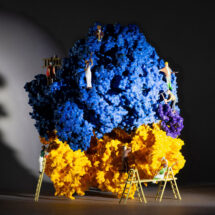
Researchers in Jason Chin’s group in the LMB’s PNAC Division have for the first time engineered and optimised a ‘stapled’ ribosome that can act as a cell-based factory for synthetic protein polymer synthesis.
We are familiar with polymers in everyday life, from nylon to kevlar and plastics. Polymers are composed of chemical compounds strung together like beads in a necklace. Most everyday polymers are made using synthetic chemistry and are composed of the same compound strung together many times. Proteins carry out many functions in cells, and are also polymers. However, proteins are more complex than most synthetic polymers because they are composed of 20 different compounds (amino acids) strung together in defined order. The increased complexity of proteins with respect to synthetic polymers means that proteins are able to perform much more sophisticated functions than synthetic polymers. It is not currently possible to create synthetic polymers with the complexity and sophisticated functions of proteins using synthetic chemistry. Jason Chin’s group has a long-term interest in creating cell-based factories that can string together complex polymers from compounds beyond the 20 common amino acids; this has the potential to revolutionise the discovery and synthesis of new classes of materials and pharmaceuticals.
Proteins are made on the ribosome, a molecular machine composed of two subunits – a small subunit that reads genetic information and a large subunit that strings together amino acids in the order prescribed by the genetic information in the genome. While the natural ribosome is essential to keep the cells alive, and cannot be altered to enable non-natural polymer synthesis, Jason’s group has previously created a second ribosome in cells that can be altered. However, the second ribosome shared the large subunit, that strings together amino acids, with the natural ribosome, and this limited the range of compounds that could be polymerised by this system.
Wolfgang Schmied, Zakir Tnimov, and Chayasith Uttamapinant, from Jason’s group, have now led an effort to create a second ribosome composed of unique large and small subunits, and shown that this new ribosome does not share subunits with the natural ribosome. They achieved this by connecting the large and small subunits of the new ribosome through an RNA hinge followed by optimization of the linker between the hinge and the new ribosome’s subunits. Characterization of more than 100 ribosome variants with linked subunits showed that the optimization step was crucial for creating a correctly functioning ribosome with the desired properties. Chris Rae, from Venki Ramakrishnan’s group in the LMB’s Structural Studies Division, solved the structure of resulting ‘stapled ribosome’ to show how the RNA connects the two subunits. Finally, in a proof of principle experiments, the team demonstrated that the new ribosome could be altered, by directed evolution, to polymerize a compound that the natural ribosome is intrinsically unable to polymerise.
These experiments provide a key advance in the development of cell-based factories that use genetic information to encode the synthesis of new polymers.
This work was funded by the MRC, the BBSRC, the ERC, a Gates Cambridge Scholarship, the Wellcome Trust, the Louis-Jeantet Foundation, the Agouron Institute, and a fellowship from King’s College, Cambridge.
Further references:
Paper in Nature
Jason Chin’s group page
Venki Ramakrishnan’s group page